FREE shipping on orders over $49!* Details
- All Products
- Home Improvement
- Building Materials
- Flooring
- Engineered Wood Flooring
Engineered Wood Flooring
Item 1 of 15
Sort by:
Price
393 Results
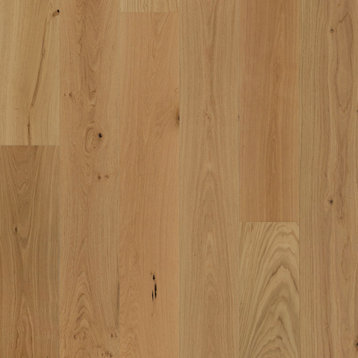
French Oak Prefinished Engineered Wood Floor, Natural, Wide Plank 7 1/2"x5/8"by Hurst Hardwoods(4)
SALE
$1$6
This listing is for one 10" long sample piece of our popular 7 1/2" x 5/8" French Oak (Natural) Prefinished Engineered wood floor from our European French Oak Collection. This wide plank wood flooring offers beautiful aesthetics to compliment your home's interior space. Featuring an 9-ply construction, tongue & groove milling profile, and micro-beveled edges/ends, this European style wood floor is both CARB Phase II certified & Lacey Act compliant. Its White Oak veneer and Birch ply core are harvested from European forests and milled on top quality German equipment to produce a superior product. This floor also boasts a 4mm top layer, allowing it to be re-sanded/re-finished up to 3 times over its lifetime. Actual flooring planks from this collection feature a majority (70%) 73" long lengths, with the balance of boards at 2' to 4'. Installation methods include glue, float, nail or staple down. Our French Oak Engineered wood floors are manufactured with Live Sawn White Oak to create an "Old World" look while also affording them increased stability and hardness. This floor's hand-scraped & distressed textures along with our high grade Aluminum Oxide matte finish provide incredible scratch resistance for busy homes of all sizes. Comes with a 30 Year Finish Warranty. For more information, please refer to our Terms & Policies for statements on moisture control, radiant heat, shipping, damage, and returns. For over 25 years, Hurst Hardwoods has been a national leading hardwood flooring wholesaler.
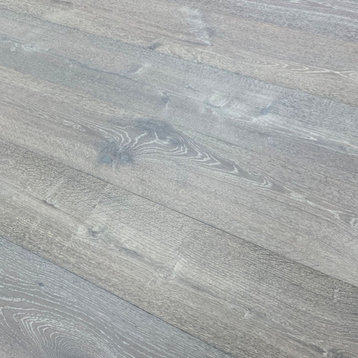
French Oak Prefinished Engineered Wood Floor, Grey Ridge, Sampleby Hurst Hardwoods(1)
$4
This listing is for one 10" long sample piece of our popular 7 1/2" x 1/2" French Oak (Grey Rdige) Prefinished Engineered wood floor from our European French Oak Collection. This wide plank wood flooring offers beautiful aesthetics to compliment your home's interior space. Featuring a tongue & groove milling profile and micro-beveled edges/ends, this European style wood floor is both CARB Phase II certified & Lacey Act compliant. Its White Oak veneer and Birch ply core are harvested from European forests and milled on top quality German equipment to produce a superior product. This floor also boasts a 3mm top layer, allowing it to be re-sanded/re-finished up to 2 times over its lifetime. Actual flooring planks from this collection feature a majority (70%) 73" long lengths, with the balance of boards at 2' to 4'. Installation methods include glue, float, nail or staple down. Our French Oak Engineered wood floors are manufactured with Live Sawn White Oak to create an "Old World" look while also affording them increased stability and hardness. This floor's lightly wire brushed texture & high grade Aluminum Oxide matte finish provide incredible scratch resistance for busy homes of all sizes. Comes with a 30 Year Finish Warranty. For more information, please refer to our Terms & Policies for statements on moisture control, radiant heat, shipping, damage, and returns. For over 27 years, Hurst Hardwoods has been a national leading hardwood flooring wholesaler.
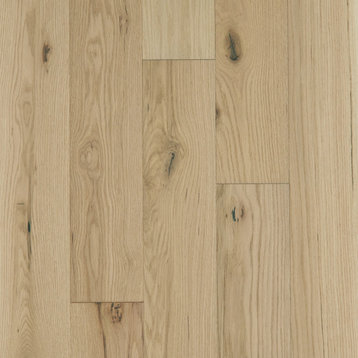
Shaw SW714 Sanctuary Oak 6-3/8"W Wirebrushed Engineered Hardwood - Firesideby Shaw
$188
Free Shipping
Please review Build.com return policy for Flooring and Tile Products, certain restrictions may apply on general returns. If flooring arrives damaged or is defective, please call for assistance (800-375-3403). Features: Sanctuary Oak Engineered Hardwood Planks are constructed of Oak featuring a wire brushed surface texture with Low gloss 1/2" thick planks feature backing layers consisting of Red Oak and are composed of 3-Plys Sanctuary Oak by Shaw displays a High Color and Character Variation rating with Micro-Beveled edges and Micro-Beveled ends Finished with Shaw's ScufResist Platinum finish, plus Repel. ScufResist is designed to help resist household scuffing, while Repel provides water-resistance to combat everyday spills and splashes, helping keep your floor look younger for longer. Sanctuary Oak by Shaw is Fade Resistant, Scratch Resistant, Stain Resistant, and Water Resistant Flooring can be installed via Nail, Staple, Glue, or Floating. Floating installation requires flooring to be glued at the tongue-and-groove joint to complete and stabilize the installation. Planks come in Random lengths from 10" to 58-9/16" and a width of 6-3/8" Flooring is not sensitive to lighting and is approved for radiant heating Sustainably manufactured in the USA Flooring is rated for residential use only and protected by a Lifetime Residential Warranty Don't forget your coordinating trim and molding Specifications: Planks measure 1/2" Thick, with a 1.2mm Face Thickness Length: Random lengths from 10" to 58-9/16" Width: 6-3/8" Installation Location: Above Grade (Upstairs), Below Grade (Basement), On Grade (Ground Level) Installation Type: Floating, Glue Down, Nail Down, Staple Down Wood Species: Oak Fade Resistant: Yes Scratch Resistant: Yes Stain Resistant: Yes Water Resistant: Yes
Best Seller
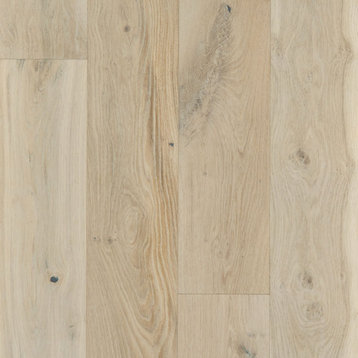
Shaw SW485 Castlewood Oak 7-1/2"W Wire Brushed Engineered - Renaissanceby Shaw(3)
$286
Free Shipping
Please review Build.com return policy for Flooring and Tile Products, certain restrictions may apply on general returns. If flooring arrives damaged or is defective, please call for assistance (800-375-3403). Features: Castlewood Oak Engineered Hardwood Planks are constructed of White Oak featuring a Wire Brushed surface texture with Low gloss 9/16" thick planks feature backing layers consisting of Poplar and are composed of 8-Plys resulting in a Janka Rating of 1004 Castlewood Oak by Shaw displays a High Color and Character Variation rating with Micro-Beveled edges and Micro-Beveled ends UV Aluminum Oxide finish prevents everyday household scuffing and keeps your floor looking as good as new. Castlewood Oak by Shaw is Fade Resistant, Scratch Resistant, and Stain Resistant Flooring can be installed via Nail, Staple, Glue, or Floating. Floating installation requires flooring to be glued at the tongue-and-groove joint to complete and stabilize the installation. Planks come in Random lengths from 13" to 74-13/16" and a width of 7-1/2" Flooring is not sensitive to lighting and is approved for radiant heating Flooring is backed by a 50 Year Residential Warranty and approved for both light and full commercial use which is protected by a 5 Year Warranty Don't forget your coordinating trim and molding Specifications: Planks measure 9/16" Thick, with a 3 mm Face Thickness Length: Random lengths from 13" to 74-13/16" Width: 7-1/2" Installation Location: Above Grade (Upstairs), Below Grade (Basement), On Grade (Ground Level) Installation Type: Floating, Glue Down, Nail Down, Staple Down Wood Species: White Oak Fade Resistant: Yes Scratch Resistant: Yes Stain Resistant: Yes
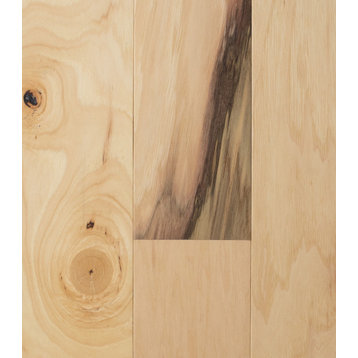
Mullican 210-DE-HI-5-L Devonshire 5"W Wire Brushed Engineered - Naturalby Mullican
$151
Free Shipping
Please review Build.com return policy for Flooring and Tile Products, certain restrictions may apply on general returns. If flooring arrives damaged or is defective, please call for assistance (800-375-3403) Features: FloorScore certified to promote healthier indoor air quality for your family All Engineered Flooring Acclimation: 1-3 Days Produced from wood Comes with a wire brushed surface and low gloss finish Fade and scratch resistant against normal wear and tear Made in America Covered under a 25 year manufacturer warranty Installation: Appropriate for installation above grade (upstairs), below grade (basement), or on grade (ground level) Uses floating, glue down, nail down, or staple down installation methods Engineered flooring acclimation: 1-3 days Specifications: Nominal: 5" x 48" Thickness: 3/8"
Best Seller
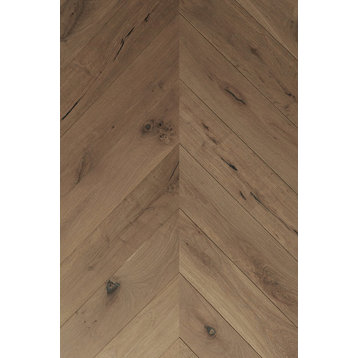
Rimini (CH) 4-3/4″ Wide - White Oak Engineered Hardwood Flooringby ADM Flooring(2)
SALE
$13.16/sq ft.$20.44/sq ft.
Free Shipping
Rimini (CH) s wear layer is constructed from 4mm solid European White Oak Hardwood and its core is comprised of layers of plywood. Chevron flooring is one of the most sought after hardwood choices in the US. All of these layers combined result in a 5/8″ total plank thickness and each plank measuring 4-3/4″ in width. With flooring manufactured by ADM, you can set up the ageless look of European White Oak engineered hardwood flooring by implementing your own design expertise to the color and finish. ADM Flooring collections provide customers with a product perfectly made for their home and budget. Rimini (CH) guarantees an economical choice within our Rustic grade. We assure you that it will give a modern feel to your current or upcoming renovation with its classic Natural European White Oak color and style combination. Each box of Rimini (CH) contains 11.25 square feet of engineered hardwood. It has Wire Brushed surface texture and the planks are 28-7/8″ long. Our flooring is constructed from layers of plywood, topped with a solid European White Oak veneer. PLEASE NOTE: True color may vary based on your monitor settings.
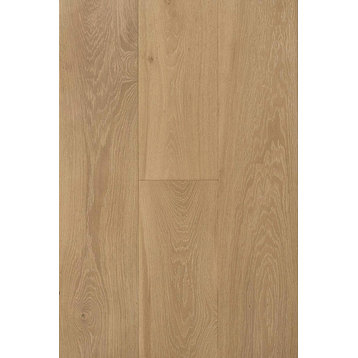
Laguna 9-1/2″ Wide - White Oak Engineered Hardwood Flooringby ADM Flooring
SALE
$8.23/sq ft.$9.41/sq ft.
Free Shipping
Lagunas wear layer is constructed from 4mm solid European White Oak Hardwood and its core is comprised of layers of plywood. Straight Plank flooring is one of the most sought after hardwood choices in the US. All of these layers combined result in a 5/8″ total plank thickness and each plank measuring 9-1/2″ in width. With flooring manufactured by ADM, you can set up the ageless look of European White Oak engineered hardwood flooring by implementing your own design expertise to the color and finish. ADM Flooring collections provide customers with a product perfectly made for their home and budget. Laguna guarantees an economical choice within our ABCD (Character) grade. We assure you that it will give a modern feel to your current or upcoming renovation with its classic Natural European White Oak color and style combination. Each box of Laguna contains 22.73 square feet of engineered hardwood. It has Wire Brushed surface texture and the planks are Random up to 7ft (Most pieces are 7ft) long. Our flooring is constructed from layers of plywood, topped with a solid European White Oak veneer. PLEASE NOTE: True color may vary based on your monitor settings.
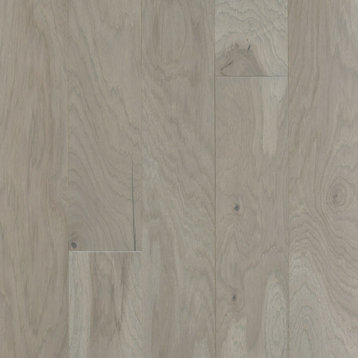
Shaw SW710 Alpine Hickory 6-3/8"W Smooth Engineered Hardwood - Centennial Grayby Shaw
$189
Free Shipping
Please review Build.com return policy for Flooring and Tile Products, certain restrictions may apply on general returns. If flooring arrives damaged or is defective, please call for assistance (800-375-3403) Features: Constructed from Hickory hardwood Made with a smooth surface for a great look and feel Proudly made in America Includes a 50 year builder and a lifetime warranty Installation: Can be installed using a floating, glue down, nail down, staple down installation using the tongue and groove locking system Can be installed above grade (upstairs), below grade (basement) or on grade (ground level)
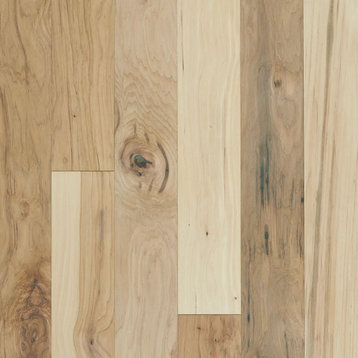
Shaw SW669 Northington Smooth 5"W Smooth Engineered Hardwood - Canopyby Shaw
$103
Free Shipping
Please review Build.com return policy for Flooring and Tile Products, certain restrictions may apply on general returns. If flooring arrives damaged or is defective, please call for assistance (800-375-3403). Features: Northington Smooth Engineered Hardwood Planks are constructed of Hickory featuring a Smooth surface texture with Low gloss 1/2" thick planks feature backing layers consisting of Hickory and are composed of 3-Plys resulting in a Janka Rating of 1754 Northington Smooth by Shaw displays a High Color and Character Variation rating with Micro-Beveled edges and Micro-Beveled ends Finished with Shaw's ScufResist Platinum finish which is designed to help resist household scuffing and keep your floor looking younger for longer. When tested, ScufResist Platinum resisted scuffing up to 6X more than the competition! Northington Smooth by Shaw is both Fade Resistant and Scratch Resistant Flooring can be installed via Nail, Staple, Glue, or Floating. Floating installation requires flooring to be glued at the tongue-and-groove joint to complete and stabilize the installation. Planks come in Random lengths from 8" to 58-1/4" and a width of 5" Flooring is not sensitive to lighting and is approved for radiant heating Sustainably manufactured in the USA Flooring is backed by a Lifetime Residential Warranty and approved for both light and full commercial use which is protected by a 5 Year Warranty Don't forget your coordinating trim and molding Specifications: Planks measure 1/2" Thick, with a 1.2 mm Face Thickness Length: Random lengths from 8" to 58-1/4" Width: 5" Installation Location: Above Grade (Upstairs), Below Grade (Basement), On Grade (Ground Level) Installation Type: Floating, Glue Down, Nail Down, Staple Down Wood Species: Hickory Fade Resistant: Yes Scratch Resistant: Yes
French Oak Prefinished Engineered Wood Floor, Grey Meadowby Hurst Hardwoods
SALE
$1$6
This listing is for one 10" long sample piece of our popular 7 1/2" x 5/8" French Oak (Grey Meadow) Prefinished Engineered wood floor from our European French Oak Collection. This wide plank wood flooring offers beautiful aesthetics to compliment your home's interior space. Featuring an 9-ply construction, tongue & groove milling profile, and micro-beveled edges/ends, this European style wood floor is both CARB Phase II certified & Lacey Act compliant. Its White Oak veneer and Birch ply core are harvested from European forests and milled on top quality German equipment to produce a superior product. This floor also boasts a 4mm top layer, allowing it to be re-sanded/re-finished up to 3 times over its lifetime. Actual flooring planks from this collection feature a majority (70%) 73" long lengths, with the balance of boards at 2' to 4'. Installation methods include glue, float, nail or staple down. Our French Oak Engineered wood floors are manufactured with Live Sawn White Oak to create an "Old World" look while also affording them increased stability and hardness. This floor's lightly wire brushed texture & high grade Aluminum Oxide matte finish provide incredible scratch resistance for busy homes of all sizes. Comes with a 30 Year Finish Warranty. For more information, please refer to our Terms & Policies for statements on moisture control, radiant heat, shipping, damage, and returns. For over 27 years, Hurst Hardwoods has been a national leading hardwood flooring wholesaler.
Shaw SW715 Sanctuary Hickory 6-3/8"W Wirebrushed Engineered, Mindfulby Shaw
$196
Free Shipping
Certain restrictions may apply on general flooring returns. If flooring arrives damaged or is defective please contact customer service.. Features: Sanctuary Hickory Engineered Hardwood Planks are constructed of Hickory featuring a wire brushed surface texture with Low gloss 1/2 inches thick planks feature backing layers consisting of Hickory and are composed of 3-Plys resulting in a Janka Rating of 1932 Sanctuary Hickory by Shaw displays a High Color and Character Variation rating with Micro-Beveled edges and Micro-Beveled ends Finished with Shaw's ScufResist Platinum finish, plus Repel. ScufResist is designed to help resist household scuffing, while Repel provides water-resistance to combat everyday spills and splashes, helping keep your floor look younger for longer. Sanctuary Hickory by Shaw is Fade Resistant, Scratch Resistant, Stain Resistant, and Water Resistant Flooring can be installed via Nail, Staple, Glue, or Floating. Floating installation requires flooring to be glued at the tongue-and-groove joint to complete and stabilize the installation. Planks come in Random lengths from 10 inches to 58-9/16 inches and a width of 6-3/8 inches Flooring is not sensitive to lighting and is approved for radiant heating Sustainably manufactured in the USA Flooring is rated for residential use only and protected by a Lifetime Residential Warranty Don't forget your coordinating trim and molding Specifications: Planks measure 1/2 inches Thick, with a 1.2mm Face Thickness Length: Random lengths from 10 inches to 58-9/16 inches Width: 6-3/8 inches Installation Location: Above Grade (Upstairs), Below Grade (Basement), On Grade (Ground Level) Installation Type: Floating, Glue Down, Nail Down, Staple Down Wood Species: Hickory Fade Resistant: Yes Scratch Resistant: Yes Stain Resistant: Yes Water Resistant: Yes
Best Seller
Parma 7-1/2″ Wide - White Oak Engineered Hardwood Flooringby ADM Flooring(4)
$7.55/sq ft.
Free Shipping
Parmas wear layer is constructed from 3mm solid European White Oak Hardwood and its core is comprised of layers of plywood. Straight Plank flooring is one of the most sought after hardwood choices in the US. All of these layers combined result in a 5/8″ total plank thickness and each plank measuring 7-1/2″ in width. With flooring manufactured by ADM, you can set up the ageless look of European White Oak engineered hardwood flooring by implementing your own design expertise to the color and finish. ADM Flooring collections provide customers with a product perfectly made for their home and budget. Parma guarantees an economical choice within our ABCD (Character) grade. We assure you that it will give a modern feel to your current or upcoming renovation with its classic Natural European White Oak color and style combination. Each box of Parma contains 22.72 square feet of engineered hardwood. It has Wire Brushed surface texture and the planks are Random up to 6ft (Most pieces are 6ft) long. Our flooring is constructed from layers of plywood, topped with a solid European White Oak veneer. PLEASE NOTE: True color may vary based on your monitor settings.
Premium European White Oak 1/2"x7-1/2"x74.8" Flooring, Crystallineby Element Flooring
$5.92/sq ft.
Free Shipping
Element European White Oak real engineered hardwood flooring can be easily disinfected and kept clean with approved hardwood floor cleaning products. Hardwood flooring can help you create a safe and sanitary haven in your home. As a natural product that is acquired by renewable forestry stewardship, Element Hardwood Flooring is kind to the environment. Element Hardwood Flooring is CARB Phase 2 and FloorScore certified for indoor air quality. With the Element European White Oak Collection, you get 9 layers of low gloss durable Bona urethane finish with aluminum oxide that will protect your investment. Element Flooring is manufactured using premium products giving you a high-end look that adds value to your home. This collection features wide planks in 1/2 in. thick x 7.5 in. Wide x Random Lengths to 74.8 in. with a minimum of 70% of planks in each case being full length. It also features a 2mm sliced sandable wear layer and has an upgraded birch back layer. Birch is the premium species for a back layer and gives you the best dimensional stability and performance for the life of the floor. Our Real Hardwood Flooring with longer, wider and premium construction will complement your decor and improve the resale value of your home.
Premium European White Oak 1/2"x7-1/2"x74.8" Flooring, Illusionby Element Flooring
$5.92/sq ft.
Free Shipping
Element European White Oak real engineered hardwood flooring can be easily disinfected and kept clean with approved hardwood floor cleaning products. Hardwood flooring can help you create a safe and sanitary haven in your home. As a natural product that is acquired by renewable forestry stewardship, Element Hardwood Flooring is kind to the environment. Element Hardwood Flooring is CARB Phase 2 and FloorScore certified for indoor air quality. With the Element European White Oak Collection, you get 9 layers of low gloss durable Bona urethane finish with aluminum oxide that will protect your investment. Element Flooring is manufactured using premium products giving you a high-end look that adds value to your home. This collection features wide planks in 1/2 thick x 7.5 Wide x Random Lengths to 74.8 with a minimum of 70% of planks in each case being full length. It also features a 2mm sliced sandable wear layer and has an upgraded birch back layer. Birch is the premium species for a back layer and gives you the best dimensional stability and performance for the life of the floor. Our Real Hardwood Flooring with longer, wider and premium construction will complement your decor and improve the resale value of your home.
Best Seller
Padua 7-1/2″ Wide – White Oak Engineered Hardwood Flooringby ADM Flooring(3)
$7.75/sq ft.
Free Shipping
ADM Flooring® collection caters to its customers with a product perfectly made for their home, and budget. With flooring manufactured by ADM, you can set up the ageless look of European oak wood engineered flooring by implementing your own design expertise to the color and finish. The Padua promises an economical choice within our ABCD grade selection and is guaranteed to add a modern feel to your current or upcoming renovation with its cloudy brown vintage color and style combination. This particular wood floor is finished with thin layers of UV Lacquer to achieve certain finish specialties like leveling, protection together with a gloss and it is also wire brushed for the benefit of fine texture while maintaining a smooth appearance. Padua is sold per box containing 22.72 sq. ft. of up to 73" panels.
Shaw SW547 Yukon Maple 5"W Heavy Scraped Engineered Hardwood - Buckskinby Shaw
$145
Free Shipping
Please review Build.com return policy for Flooring and Tile Products, certain restrictions may apply on general returns. If flooring arrives damaged or is defective, please call for assistance (800-375-3403). Features: Yukon Maple 5" Engineered Hardwood Planks are constructed of Maple featuring a Heavy Scraped surface texture with Medium gloss 3/8" thick planks feature backing layers consisting of Maple and are composed of 3-Plys resulting in a Janka Rating of 2233 Yukon Maple 5" by Shaw displays a High Color and Character Variation rating with Pillowed edges and Pillowed ends Finished with Shaw's ScufResist Platinum finish which is designed to help resist household scuffing and keep your floor looking younger for longer. When tested, ScufResist Platinum resisted scuffing up to 6X more than the competition! Yukon Maple 5" by Shaw is both Fade Resistant and Scratch Resistant Flooring can be installed via Nail, Staple, Glue, or Floating. Floating installation requires flooring to be glued at the tongue-and-groove joint to complete and stabilize the installation. Planks come in Random lengths from 10" to 58-1/2" and a width of 5" Flooring is not sensitive to lighting and is approved for radiant heating Sustainably manufactured in the USA Flooring is backed by a Lifetime Residential Warranty and approved for both light and full commercial use which is protected by a 5 Year Warranty Don't forget your coordinating trim and molding Specifications: Planks measure 3/8" Thick, with a 1.2 mm Face Thickness Length: Random lengths from 10" to 58-1/2" Width: 5" Installation Location: Above Grade (Upstairs), Below Grade (Basement), On Grade (Ground Level) Installation Type: Floating, Glue Down, Nail Down, Staple Down Wood Species: Maple Fade Resistant: Yes Scratch Resistant: Yes
Premium Hickory 9/16"x8.66"x86.6" Flooring, Windchillby Element Flooring
$7.90/sq ft.
Free Shipping
Element American Hickory real engineered hardwood flooring can be easily disinfected and kept clean with approved hardwood floor cleaning products. Hardwood flooring can help you create a safe and sanitary haven in your home. As a natural product that is acquired by renewable forestry stewardship, Element Hardwood Flooring is kind to the environment. Element Hardwood Flooring is CARB Phase 2 and FloorScore certified for indoor air quality. With the Element American Hickory Collection, you get 9 layers of low gloss durable Bona urethane finish with aluminum oxide that will protect your investment. Element Flooring is manufactured using premium products giving you a high-end look that adds value to your home. This collection features wide planks in 9/16 thick x 8.66 Wide x Random Lengths to 86.6 with a minimum of 70% of planks in each case being full length. It also features a 3mm sawn sandable wear layer and has an upgraded birch back layer. Birch is the premium species for a back layer and gives you the best dimensional stability and performance for the life of the floor. Our Real Hardwood Flooring with longer, wider and premium construction will complement your decor and improve the resale value of your home.
Premium European White Oak 1/2"x7-1/2"x74.8" Flooring, Accoladeby Element Flooring
$5.92/sq ft.
Free Shipping
Element European White Oak real engineered hardwood flooring can be easily disinfected and kept clean with approved hardwood floor cleaning products. Hardwood flooring can help you create a safe and sanitary haven in your home. As a natural product that is acquired by renewable forestry stewardship, Element Hardwood Flooring is kind to the environment. Element Hardwood Flooring is CARB Phase 2 and FloorScore certified for indoor air quality. With the Element European White Oak Collection, you get 9 layers of low gloss durable Bona urethane finish with aluminum oxide that will protect your investment. Element Flooring is manufactured using premium products giving you a high-end look that adds value to your home. This collection features wide planks in 1/2 thick x 7.5 Wide x Random Lengths to 74.8 with a minimum of 70% of planks in each case being full length. It also features a 2mm sliced sandable wear layer and has an upgraded birch back layer. Birch is the premium species for a back layer and gives you the best dimensional stability and performance for the life of the floor. Our Real Hardwood Flooring with longer, wider and premium construction will complement your decor and improve the resale value of your home.
Premium Hickory 1/2"x7-1/2"x74.8" Flooring, Whisperby Element Flooring
$5.92/sq ft.
Free Shipping
Element American Hickory engineered hardwood flooring can be easily disinfected and kept clean with approved hardwood floor cleaning products. Hardwood flooring can help you create a safe and sanitary haven in your home. As a natural product that is acquired by renewable forestry stewardship, our flooring is kind to the environment. With CARB Phase 2 and FloorScore certification we ensure good indoor air quality. Element American Hickory Collection, has 9 layers of low gloss durable Bona urethane finish with aluminum oxide that will protect your investment. This collection features wide planks in 1/2 thick x 7.5 Wide x Random Lengths to 74.8 a minimum of 70% of planks in each carton being full length. The 2mm sliced wear layer is sandable and has an upgraded birch back layer. Birch is the premium species for a back layer and gives you the best dimensional stability and performance for the life of the floor. Our Real Hardwood Flooring with longer, wider and premium construction will complement your decor and improve the resale value of your home.
Shaw SW660 Reflections Maple 7"W Smooth Engineered Hardwood - Vistaby Shaw(3)
$189
Free Shipping
Please review Build.com return policy for Flooring and Tile Products, certain restrictions may apply on general returns. If flooring arrives damaged or is defective, please call for assistance (800-375-3403). Features: Reflections Maple Engineered Hardwood Planks are constructed of Maple featuring a Smooth surface texture with Low gloss 1/2" thick planks feature backing layers consisting of Oak, Birch or Maple and are composed of 3-Plys resulting in a Janka Rating of 1842 Reflections Maple by Shaw displays a High Color and Character Variation rating with Micro-Beveled edges and Micro-Beveled ends Finished with Shaw's ScufResist Platinum finish, plus Repel. ScufResist is designed to help resist household scuffing, while Repel provides water-resistance to combat everyday spills and splashes, helping keep your floor look younger for longer. Reflections Maple by Shaw is Fade Resistant, Scratch Resistant, Stain Resistant, and Water Resistant Flooring can be installed via Nail, Staple, Glue, or Floating. Floating installation requires flooring to be glued at the tongue-and-groove joint to complete and stabilize the installation. Planks come in Random lengths from 16" to 82-1/2" and a width of 7" Flooring is not sensitive to lighting and is approved for radiant heating Sustainably manufactured in the USA Flooring is backed by a Lifetime Residential Warranty and approved for both light and full commercial use which is protected by a 5 Year Warranty Don't forget your coordinating trim and molding Specifications: Planks measure 1/2" Thick, with a 1.2 mm Face Thickness Length: Random lengths from 16" to 82-1/2" Width: 7" Installation Location: Above Grade (Upstairs), Below Grade (Basement), On Grade (Ground Level) Installation Type: Floating, Glue Down, Nail Down, Staple Down Wood Species: Maple Fade Resistant: Yes Scratch Resistant: Yes Stain Resistant: Yes Water Resistant: Yes
Sunset 9-1/2″ Wide - White Oak Engineered Hardwood Flooringby ADM Flooring
$8.23/sq ft.
Free Shipping
Sunsets wear layer is constructed from 4mm solid European White Oak Hardwood and its core is comprised of layers of plywood. Straight Plank flooring is one of the most sought after hardwood choices in the US. All of these layers combined result in a 5/8″ total plank thickness and each plank measuring 9-1/2″ in width. With flooring manufactured by ADM, you can set up the ageless look of European White Oak engineered hardwood flooring by implementing your own design expertise to the color and finish. ADM Flooring collections provide customers with a product perfectly made for their home and budget. Sunset guarantees an economical choice within our ABCD (Character) grade. We assure you that it will give a modern feel to your current or upcoming renovation with its classic Light European White Oak color and style combination. Each box of Sunset contains 22.73 square feet of engineered hardwood. It has Wire Brushed surface texture and the planks are Random up to 7ft (Most pieces are 7ft) long. Our flooring is constructed from layers of plywood, topped with a solid European White Oak veneer. PLEASE NOTE: True color may vary based on your monitor settings.
Moon Shadow 10-1/4″ Wide - White Oak Engineered Hardwood Flooringby ADM Flooring
$8.53/sq ft.
Free Shipping
Moon Shadows wear layer is constructed from 4mm solid European White Oak Hardwood and its core is comprised of layers of plywood. Straight Plank flooring is one of the most sought after hardwood choices in the US. All of these layers combined result in a 5/8″ total plank thickness and each plank measuring 10-1/4″ in width. With flooring manufactured by ADM, you can set up the ageless look of European White Oak engineered hardwood flooring by implementing your own design expertise to the color and finish. ADM Flooring collections provide customers with a product perfectly made for their home and budget. Moon Shadow guarantees an economical choice within our ABCD (Character) grade. We assure you that it will give a modern feel to your current or upcoming renovation with its classic Natural European White Oak color and style combination. Each box of Moon Shadow contains 24.63 square feet of engineered hardwood. It has Wire Brushed surface texture and the planks are Random up to 7ft (Most pieces are 7ft) long. Our flooring is constructed from layers of plywood, topped with a solid European White Oak veneer. PLEASE NOTE: True color may vary based on your monitor settings.
Best Seller
Shaw SW592 Fremont Hickory 5"W Heavy Scraped Engineered Hardwood - Pathwayby Shaw(14)
$119
Free Shipping
Please review Build.com return policy for Flooring and Tile Products, certain restrictions may apply on general returns. If flooring arrives damaged or is defective, please call for assistance (800-375-3403). Features: Fremont Hickory Engineered Hardwood Planks are constructed of Hickory featuring a Heavy Scraped surface texture with Medium gloss 3/8" thick planks feature backing layers consisting of Hickory and are composed of 3-Plys resulting in a Janka Rating of 2584 Fremont Hickory by Shaw displays a High Color and Character Variation rating with Pillowed edges and Pillowed ends Finished with Shaw's ScufResist Platinum finish which is designed to help resist household scuffing and keep your floor looking younger for longer. When tested, ScufResist Platinum resisted scuffing up to 6X more than the competition! Fremont Hickory by Shaw is both Fade Resistant and Scratch Resistant Flooring can be installed via Nail, Staple, Glue, or Floating. Floating installation requires flooring to be glued at the tongue-and-groove joint to complete and stabilize the installation. Planks come in Random lengths from 10" to 58-1/2" and a width of 5" Flooring is not sensitive to lighting and is approved for radiant heating Sustainably manufactured in the USA Flooring is backed by a Lifetime Residential Warranty and approved for both light and full commercial use which is protected by a 5 Year Warranty Don't forget your coordinating trim and molding Specifications: Planks measure 3/8" Thick, with a 1.2 mm Face Thickness Length: Random lengths from 10" to 58-1/2" Width: 5" Installation Location: Above Grade (Upstairs), Below Grade (Basement), On Grade (Ground Level) Installation Type: Floating, Glue Down, Nail Down, Staple Down Wood Species: Hickory Fade Resistant: Yes Scratch Resistant: Yes
AFY19001 Hickory DarkWood 7-1/2" W 1/2" Thick, 2mm WearLayer Engineered hardwoodby Yulf Design and Flooring
$465
Free Shipping
Mistery Garden-Engineered HardWood;
- 7 1/2" Wide, 1/2" Thick, 2mm Wear Layer;
- Minimum length: 23.5"/pcs;
- Maximum length: 75''/pcs;
- 31.09sqft /box;
Features;
- Carb 93102;
- Overall Product Weight: 45 lb/box;
- Box/Pattet: 40;
Product Details;
- Species: Hickory;
- Construction: Engineered wood;
- Surface Texture: Wire-brushed;
- Finish: Dark Brown;
- Wood Color: Tan Wood;
- Gloss Level: Low gloss;
- Edge Type: Square;
- Protective Coating: Yes;
- Installation Location: Above grade; On grade; Below grade;
- Installation Type: Click lock;
- Product Warranty: 25 years;
- Underlayment Recommended: No;
- Compatible Subfloor Types: Concrete; Wooden;
- Janka Hardness Rating (PSI): 1820;
- Natural Variation
- Wood Knots(Round, dark spots in the wood.)
- Natural Wood Grain Color Variation(No item has the same grain color, finish, or wood knots due to natural factors.)
Shaw SW695 Timeless Oak 5"W Smooth Engineered Hardwood Flooring - Naturalby Shaw
$103
Free Shipping
Please review Build.com return policy for Flooring and Tile Products, certain restrictions may apply on general returns. If flooring arrives damaged or is defective, please call for assistance (800-375-3403). Features: Timeless Oak 5" Engineered Hardwood Planks are constructed of Red Oak featuring a Smooth surface texture with Medium gloss 1/2" thick planks feature backing layers consisting of Red Oak and are composed of 3-Plys resulting in a Janka Rating of 1627 Timeless Oak 5" by Shaw displays a High Color and Character Variation rating with Micro-Beveled edges and Micro-Beveled ends Finished with Shaw's ScufResist Platinum finish which is designed to help resist household scuffing and keep your floor looking younger for longer. When tested, ScufResist Platinum resisted scuffing up to 6X more than the competition! Timeless Oak 5" by Shaw is both Fade Resistant and Scratch Resistant Flooring can be installed via Nail, Staple, Glue, or Floating. Floating installation requires flooring to be glued at the tongue-and-groove joint to complete and stabilize the installation. Planks come in Random lengths from 8" to 58-1/4" and a width of 5" Flooring is not sensitive to lighting and is approved for radiant heating Sustainably manufactured in the USA Flooring is backed by a Lifetime Residential Warranty and approved for both light and full commercial use which is protected by a 5 Year Warranty Don't forget your coordinating trim and molding Specifications: Planks measure 1/2" Thick, with a 1.2 mm Face Thickness Length: Random lengths from 8" to 58-1/4" Width: 5" Installation Location: Above Grade (Upstairs), Below Grade (Basement), On Grade (Ground Level) Installation Type: Floating, Glue Down, Nail Down, Staple Down Wood Species: Red Oak Fade Resistant: Yes Scratch Resistant: Yes
French Oak Prefinished Engineered Wood Floor, Oregonby Hurst Hardwoods(1)
SALE
$1$6
This listing is for one 10" long sample piece of our popular 7 1/2" x 5/8" French Oak (Oregon) Prefinished Engineered wood floor from our European French Oak Collection. This wide plank wood flooring offers beautiful aesthetics to compliment your home's interior space. Featuring an 9-ply construction, tongue & groove milling profile, and micro-beveled edges/ends, this European style wood floor is both CARB Phase II certified & Lacey Act compliant. Its White Oak veneer and Birch ply core are harvested from European forests and milled on top quality German equipment to produce a superior product. This floor also boasts a 4mm top layer, allowing it to be re-sanded/re-finished up to 3 times over its lifetime. Actual flooring planks from this collection feature a majority (70%) 73" long lengths, with the balance of boards at 2' to 4'. Installation methods include glue, float, nail or staple down. Our French Oak Engineered wood floors are manufactured with Live Sawn White Oak to create an "Old World" look while also affording them increased stability and hardness. This floor's lightly wire brushed texture & high grade Aluminum Oxide matte finish provide incredible scratch resistance for busy homes of all sizes. Comes with a 30 Year Finish Warranty. For more information, please refer to our Terms & Policies for statements on moisture control, radiant heat, shipping, damage, and returns. For over 27 years, Hurst Hardwoods has been a national leading hardwood flooring wholesaler.
Best Seller
Vicenza 7-1/2″ Wide - White Oak Engineered Hardwood Flooringby ADM Flooring(4)
$7.55/sq ft.
Free Shipping
Vicenzas wear layer is constructed from 3mm solid European White Oak Hardwood and its core is comprised of layers of plywood. Straight Plank flooring is one of the most sought after hardwood choices in the US. All of these layers combined result in a 5/8″ total plank thickness and each plank measuring 7-1/2″ in width. With flooring manufactured by ADM, you can set up the ageless look of European White Oak engineered hardwood flooring by implementing your own design expertise to the color and finish. ADM Flooring collections provide customers with a product perfectly made for their home and budget. Vicenza guarantees an economical choice within our ABCD (Character) grade. We assure you that it will give a modern feel to your current or upcoming renovation with its classic Natural European White Oak color and style combination. Each box of Vicenza contains 22.72 square feet of engineered hardwood. It has Wire Brushed surface texture and the planks are Random up to 6ft (Most pieces are 6ft) long. Our flooring is constructed from layers of plywood, topped with a solid European White Oak veneer. PLEASE NOTE: True color may vary based on your monitor settings.
Best Seller
Modena 7-1/2″ Wide - White Oak Engineered Hardwood Flooringby ADM Flooring(4)
$9.95/sq ft.
Free Shipping
Modenas wear layer is constructed from 3mm solid European White Oak Hardwood and its core is comprised of layers of plywood. Straight Plank flooring is one of the most sought after hardwood choices in the US. All of these layers combined result in a 5/8″ total plank thickness and each plank measuring 7-1/2″ in width. With flooring manufactured by ADM, you can set up the ageless look of European White Oak engineered hardwood flooring by implementing your own design expertise to the color and finish. ADM Flooring collections provide customers with a product perfectly made for their home and budget. Modena guarantees an economical choice within our Select grade. We assure you that it will give a modern feel to your current or upcoming renovation with its classic Light European White Oak color and style combination. Each box of Modena contains 22.72 square feet of engineered hardwood. It has Wire Brushed surface texture and the planks are Random Up to 73″ (Most pieces are 73″) long. Our flooring is constructed from layers of plywood, topped with a solid European White Oak veneer. PLEASE NOTE: True color may vary based on your monitor settings.
Vernazza 7-1/2″ Wide – White Oak Engineered Hardwood Flooringby ADM Flooring
$7.75/sq ft.
Free Shipping
ADM Flooring® collection caters to its customers with a product perfectly made for their home, and budget. With flooring manufactured by ADM, you can set up the ageless look of European oak wood engineered flooring by implementing your own design expertise to the color and finish. The Vernazza promises an economical choice within our ABCD grade selection and is guaranteed to add a contemporary feel to your current or upcoming renovation with its light brown vintage color and style combination. This particular wood floor is finished with thin layers of UV Lacquer to achieve certain finish specialties like leveling, protection together with a gloss and it is also wire brushed for the benefit of fine texture while maintaining a smooth appearance. Vernazza is sold per box containing 22.72 sq. ft. of up to 73" panels.
Alsip - Euro White Oak 1/2"x 7.5"x 18"-74" Length Engineered Hardwood Flooringby Element Flooring
$170
Free Shipping
Alsip - Euro White Oak 1/2" Thick x 7.5" Width x 18" - 74" Varying Length Engineered Hardwood Flooring (30.4 sq. ft./case)
Shaw SW485 Castlewood Oak 7-1/2"W Wire Brushed Engineered - Dynastyby Shaw(3)
$286
Free Shipping
Please review Build.com return policy for Flooring and Tile Products, certain restrictions may apply on general returns. If flooring arrives damaged or is defective, please call for assistance (800-375-3403). Features: Castlewood Oak Engineered Hardwood Planks are constructed of White Oak featuring a Wire Brushed surface texture with Low gloss 9/16" thick planks feature backing layers consisting of Poplar and are composed of 8-Plys resulting in a Janka Rating of 1004 Castlewood Oak by Shaw displays a High Color and Character Variation rating with Micro-Beveled edges and Micro-Beveled ends UV Aluminum Oxide finish prevents everyday household scuffing and keeps your floor looking as good as new. Castlewood Oak by Shaw is Fade Resistant, Scratch Resistant, and Stain Resistant Flooring can be installed via Nail, Staple, Glue, or Floating. Floating installation requires flooring to be glued at the tongue-and-groove joint to complete and stabilize the installation. Planks come in Random lengths from 13" to 74-13/16" and a width of 7-1/2" Flooring is not sensitive to lighting and is approved for radiant heating Flooring is backed by a 50 Year Residential Warranty and approved for both light and full commercial use which is protected by a 5 Year Warranty Don't forget your coordinating trim and molding Specifications: Planks measure 9/16" Thick, with a 3 mm Face Thickness Length: Random lengths from 13" to 74-13/16" Width: 7-1/2" Installation Location: Above Grade (Upstairs), Below Grade (Basement), On Grade (Ground Level) Installation Type: Floating, Glue Down, Nail Down, Staple Down Wood Species: White Oak Fade Resistant: Yes Scratch Resistant: Yes Stain Resistant: Yes
Mullican 199-NP-OA-5-D Newtown Plank 5"W Smooth Engineered Oak - Graniteby Mullican
$176
Free Shipping
Please review Build.com return policy for Flooring and Tile Products, certain restrictions may apply on general returns. If flooring arrives damaged or is defective, please call for assistance (800-375-3403) Features: FloorScore certified to promote healthier indoor air quality for your family All Engineered Flooring Acclimation: 1-3 Days Produced from wood Comes with a smooth surface and low gloss finish Fade and scratch resistant against normal wear and tear Made in America Covered under a 25 year manufacturer warranty Installation: Appropriate for installation above grade (upstairs), below grade (basement), or on grade (ground level) Uses floating, glue down, nail down, or staple down installation methods Engineered flooring acclimation: 1-3 days Specifications: Nominal: 5" x 48" Thickness: 1/2"
Shaw SW550 Belle Grove 5"W Distressed Engineered Hardwood - Shadowby Shaw
$149
Free Shipping
Please review Build.com return policy for Flooring and Tile Products, certain restrictions may apply on general returns. If flooring arrives damaged or is defective, please call for assistance (800-375-3403). Features: Belle Grove Engineered Hardwood Planks are constructed of Hickory featuring a Distressed surface texture with Medium gloss 3/8" thick planks feature backing layers consisting of Hickory and are composed of 3-Plys resulting in a Janka Rating of 2584 Belle Grove by Shaw displays a High Color and Character Variation rating with Micro-Beveled edges and Micro-Beveled ends Finished with Shaw's ScufResist Platinum finish which is designed to help resist household scuffing and keep your floor looking younger for longer. When tested, ScufResist Platinum resisted scuffing up to 6X more than the competition! Belle Grove by Shaw is both Fade Resistant and Scratch Resistant Flooring can be installed via Nail, Staple, Glue, or Floating. Floating installation requires flooring to be glued at the tongue-and-groove joint to complete and stabilize the installation. Planks come in Random lengths from 10" to 58-1/2" and a width of 5" Flooring is not sensitive to lighting and is approved for radiant heating Sustainably manufactured in the USA Flooring is backed by a Lifetime Residential Warranty and approved for both light and full commercial use which is protected by a 5 Year Warranty Don't forget your coordinating trim and molding Specifications: Planks measure 3/8" Thick, with a 1.2 mm Face Thickness Length: Random lengths from 10" to 58-1/2" Width: 5" Installation Location: Above Grade (Upstairs), Below Grade (Basement), On Grade (Ground Level) Installation Type: Floating, Glue Down, Nail Down, Staple Down Wood Species: Hickory Fade Resistant: Yes Scratch Resistant: Yes
Best Seller
Bergamo 31-1/2″ Wide - White Oak Engineered Hardwood Flooringby ADM Flooring(3)
$15.67/sq ft.
Free Shipping
Bergamos wear layer is constructed from 4mm solid European White Oak Hardwood and its core is comprised of layers of plywood. Versailles Panel flooring is one of the most sought after hardwood choices in the US. All of these layers combined result in a 3/4″ total plank thickness and each plank measuring 31-1/2″ in width. With flooring manufactured by ADM, you can set up the ageless look of European White Oak engineered hardwood flooring by implementing your own design expertise to the color and finish. ADM Flooring collections provide customers with a product perfectly made for their home and budget. Bergamo guarantees an economical choice within our Rustic grade. We assure you that it will give a modern feel to your current or upcoming renovation with its classic Natural European White Oak color and style combination. Each box of Bergamo contains 13.78 square feet of engineered hardwood. It has Wire Brushed surface texture and the planks are 31-1/2″ long. Our flooring is constructed from layers of plywood, topped with a solid European White Oak veneer. PLEASE NOTE: True color may vary based on your monitor settings.
Best Seller
Turin 4-3/4″ Wide - White Oak Engineered Hardwood Flooringby ADM Flooring(2)
$14.09/sq ft.
Free Shipping
Turins wear layer is constructed from 4mm solid European White Oak Hardwood and its core is comprised of layers of plywood. Herringbone flooring is one of the most sought after hardwood choices in the US. All of these layers combined result in a 5/8″ total plank thickness and each plank measuring 4-3/4″ in width. With flooring manufactured by ADM, you can set up the ageless look of European White Oak engineered hardwood flooring by implementing your own design expertise to the color and finish. ADM Flooring collections provide customers with a product perfectly made for their home and budget. Turin guarantees an economical choice within our Rustic grade. We assure you that it will give a modern feel to your current or upcoming renovation with its classic Natural European White Oak color and style combination. Each box of Turin contains 9.30 square feet of engineered hardwood. It has Wire Brushed surface texture and the planks are 23-5/8″ long. Our flooring is constructed from layers of plywood, topped with a solid European White Oak veneer. PLEASE NOTE: True color may vary based on your monitor settings.
Shaw SW712 High Plains 6-3/8"W Wire Brushed Engineered Hardwood - Sumacby Shaw
$192
Free Shipping
Please review Build.com return policy for Flooring and Tile Products, certain restrictions may apply on general returns. If flooring arrives damaged or is defective, please call for assistance (800-375-3403). Features: High Plains 6-3/8" Engineered Hardwood Planks are constructed of Hickory featuring a Wire Brushed surface texture with Low gloss 3/8" thick planks feature backing layers consisting of Hickory and are composed of 3-Plys resulting in a Janka Rating of 2584 High Plains 6-3/8" by Shaw displays a High Color and Character Variation rating with Pillowed edges and Pillowed ends Finished with Shaw's ScufResist Platinum finish, plus Repel. ScufResist is designed to help resist household scuffing, while Repel provides water-resistance to combat everyday spills and splashes, helping keep your floor look younger for longer. High Plains 6-3/8" by Shaw is Fade Resistant, Scratch Resistant, Stain Resistant, and Water Resistant Flooring can be installed via Nail, Staple, Glue, or Floating. Floating installation requires flooring to be glued at the tongue-and-groove joint to complete and stabilize the installation. Planks come in Random lengths from 10" to 58 1/2" and a width of 6-3/8" Flooring is sensitive to lighting and is approved for radiant heating Sustainably manufactured in the USA Flooring is rated for residential use only and protected by a Lifetime Residential Warranty Don't forget your coordinating trim and molding Specifications: Planks measure 3/8" Thick, with a 1.2 mm Face Thickness Length: Random lengths from 10" to 58 1/2" Width: 6-3/8" Installation Location: Above Grade (Upstairs), Below Grade (Basement), On Grade (Ground Level) Installation Type: Floating, Glue Down, Nail Down, Staple Down Wood Species: Hickory Fade Resistant: Yes Scratch Resistant: Yes Stain Resistant: Yes Water Resistant: Yes
Engineered hardwood flooring may not have the same ring to it as solid hardwood, but it sure does check all of the boxes when it comes to function and style. Comparable to what most people refer to as “real wood”, engineered wood floors actually go above and beyond to perform in situations where the real stuff cannot. If you are considering replacing your current floors, read on to find out why engineered hardwood might be the perfect solution.
Engineered hardwood floors are comprised of a solid wood top layer, followed by multiple layers of manufactured wood, called ‘plies’, that are fused together with heat and pressure. The bottom, or backing, is often made of solid wood as well. This layering combination makes for a super durable product that can stand up to wear-and-tear — pre-finished variations take everyday bangs, batters and spills like a champ, and can last just as long as some solid wood options.
Adapts to humidity: Engineered wood is great for high-moisture zones like basements, bathrooms and concrete slab foundations, because it is less susceptible to expanding, contracting and buckling than regular plank wood floors.
Variety of design: With an array of options, you can find pretty much any texture or color of engineered floors you desire. This means it’s often a better alternative to getting solid planks of more exotic species, since your dollar will stretch further and you’ll be using about half as many trees as solid wood floors do.
Easy installation: Engineered hardwood is versatile for the fact that it can be installed as “floating”, or click lock, floors, where the planks are attached to each other instead of being nailed or glued down to the subfloor. This means the average DIYer can actually install them without hiring a professional. This ease of installation can bring down the price of engineered floors significantly, making them a more budget-friendly option for most people.
The one downfall to engineered flooring is that it can’t be refinished as many times as solid hardwood. Typically one to two times throughout their lifespan will be the maximum. Cheaper, thinner versions cannot be refinished at all, so beware of prices that sound too good to be true; they often mean low quality. With good quality engineered wood floors, you’ll get a lifespan of 30 to 100 years depending on foot traffic and proper maintenance.
What is engineered wood flooring?
Engineered hardwood floors are comprised of a solid wood top layer, followed by multiple layers of manufactured wood, called ‘plies’, that are fused together with heat and pressure. The bottom, or backing, is often made of solid wood as well. This layering combination makes for a super durable product that can stand up to wear-and-tear — pre-finished variations take everyday bangs, batters and spills like a champ, and can last just as long as some solid wood options.
What are the benefits of using engineered hardwood flooring?
Adapts to humidity: Engineered wood is great for high-moisture zones like basements, bathrooms and concrete slab foundations, because it is less susceptible to expanding, contracting and buckling than regular plank wood floors.
Variety of design: With an array of options, you can find pretty much any texture or color of engineered floors you desire. This means it’s often a better alternative to getting solid planks of more exotic species, since your dollar will stretch further and you’ll be using about half as many trees as solid wood floors do.
Easy installation: Engineered hardwood is versatile for the fact that it can be installed as “floating”, or click lock, floors, where the planks are attached to each other instead of being nailed or glued down to the subfloor. This means the average DIYer can actually install them without hiring a professional. This ease of installation can bring down the price of engineered floors significantly, making them a more budget-friendly option for most people.
The one downfall to engineered flooring is that it can’t be refinished as many times as solid hardwood. Typically one to two times throughout their lifespan will be the maximum. Cheaper, thinner versions cannot be refinished at all, so beware of prices that sound too good to be true; they often mean low quality. With good quality engineered wood floors, you’ll get a lifespan of 30 to 100 years depending on foot traffic and proper maintenance.






